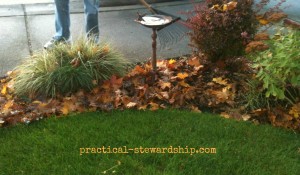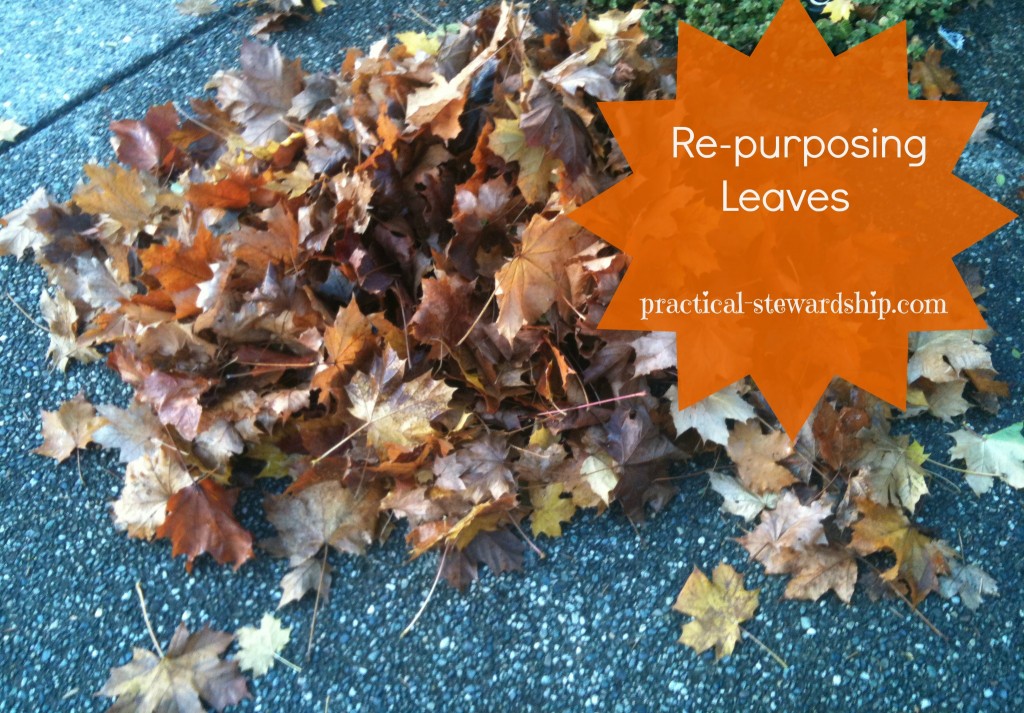It’s DIY FRI. , where every week I try to post something you can do yourself rather than buy, which is a money saver, and can be VERY REWARDING. Some of these posts are crafts, sewing projects, homemade cleaners, homemade health aids, tutorials, and the like.
Oh, how I have a hard time saying “goodbye” to summer, as the days become shorter, the nights grow longer, and the weather grows colder. We oftentimes have beautiful Septembers, and this September took the cake! But alas, fall is here, and I have been learning over the last couple of years to really enjoy the beauty of the changing seasons. The Lord has adorned the Pacific Northwest with golds, chocolates and crimsons, and these beautiful leaves are EVERYWHERE!!
Leaves can be charming and delightful, utilized in fun, fall centerpieces and entertaining kids’ crafts. They can also be an an uncontrollable handful (sounds like having kids at times:-) ), and they can be instrumental in clogging your gutters.
Do you need something to do with your leaves that will save you time, energy, and money?

 Just rake your leaves onto your flower beds and vegetable gardens! Some people like to dry out their leaves and shred them. Since we are in the soggy Pacific Northwest, I don’t bother drying out our leaves before placing the leaves on the beds.
Just rake your leaves onto your flower beds and vegetable gardens! Some people like to dry out their leaves and shred them. Since we are in the soggy Pacific Northwest, I don’t bother drying out our leaves before placing the leaves on the beds.
There are a few things that I love about using leaves from our yard.
- I love how you can do two things at once with the leaves, cleaning them up while raking them right into the beds.
- I love how leaves are an organic way to help keep those bothersome weeds down without worrying if your kids are going to roll around in man-made chemicals.
- The leaves introduce organic matter and nutrients to the soil.
- Using leaves is a frugal way to minimize the weeds that come up. Last year I was amazed how much better our yard looked after the winter, when we removed the leaves compared to years past.
Alternatively, I have some different friends that I have given newspapers to this autumn with which to cover their garden beds.
If you have roses, you can cover the root ball as a nice protective shield over the winter.
In need of leaves? If you live in an area with deciduous trees, I am sure plenty of your friends and neighbors would love for you to take some leaves off their hands.
How do you use leaves? What kind of frugal garden tips do you have to share?
Update** Don’t use walnut tree leaves because they release a chemical, juglone, that is toxic to some living things, including other plants and humans.
We would love to hear from you! Feel free to comment. Get free e-mail updates by subscribing here. Follow us on Facebook and Twitter. “Moreover, it is required of stewards that they be found faithful” (1 Corinthians 4:2 ESV). Thanks for visiting!
Sonja


Awesome! We don’t have room for all of them in our yard debris bin, so this way we can do some of them in the Autumn and some in the Spring! Plus avoid some weeding! Thanks for the great idea!!!
You are welcome!
Interesting idea! At the end of winter, is there much to clean up?
Hi Michele, yes you do have clean-up, and it goes so fast! It’s actually fun, too, because you are, at the same time, doing a big reveal of the garden. Just take the leaves or swoop them up with your hands. Thanks for visiting!
Love this idea! Even though we have three trees in our yard, there were surprisingly few leaves for our compost pile. (Especially since one of them is–I think—a young black walnut and can be toxic, so I left those leaves out)
I love the idea of raking neighbor’s leaves. You’re right. I’m sure they wouldn’t mind!
Hi! I am not sure what trees grow in your area. Just wanted to throw out a warning. I knew not to use Black Walnut leaves or chippings on my garden, berries or flowers. What I did not know was that shag bark Hickory trees produce the same chemical (that is slipping my mind right now!).
We found this out the hard way. Hubby cleaned up the woods between our house and his mom’s and put the leaves and hickory nut shells on the vegetable garden. Things just would NOT grow the next spring. We had a picture frame of stuff that grew on the outside edge. I was reading an old garden book late one night and figured it out. Took us 4 years, several loads of sheep manure, a lot of tilling and ground covers to recover.
Be careful what leaves you use. Oak and maple are great. Others, check before using. Sorry for the length of this!
Hi Mary, What does the chemical do? Thanks so much for sharing! I love learning from others. We have maple trees, so we haven’t had any problems.
Great tip! I never thought of using leaves to help with weeds. I will try this this winter! Hopping over from Tiny Tip Tuesday!
Great idea! We usually do this in our garden beds as well. This time of year leaves are all over the chicken run, so we like to rake them up and put some scratch on top and let the chickens have fun tearing the piles apart! Then we put some of the torn up leaves as extra bedding in their coop along with the pine shavings.
Visiting from farmgirl friday blog hop 🙂 Have a great weekend! Tammy
I actually rake up leaves from our street gutters so I can pile the yard really deeply with them! We have a lot of perennial flowering plants that need to be protected from the cold in order to re-seed themselves or to survive as a bulb or bush.
The back part of our back yard drops off in a very steep slope. We dump a lot of leaves there every year to control erosion and eventually decay into soil. In spring when we scoop most of the leaves out of the flowerbeds, we dump those down the slope too. There’s a lot of wind on that slope, so some of the leaves blow away, and it seems impossible to have too many!
Hi ‘Becca, Thanks for sharing! We also live on a hill. There is no flat part to our yard at all! Sounds like you have a good routine going. Have a great weekend!